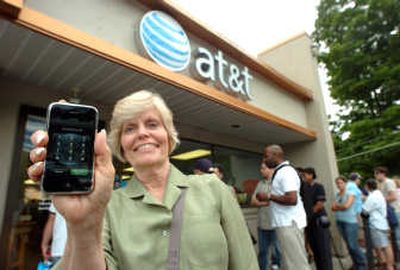Cell phone industry rings in change

NEW YORK — Among consumers, the excitement around Apple Inc.’s iPhone, launching on Friday, centers on its cool looks and innovative interface.
In the cell phone industry, the iPhone will be closely watched because it breaks several conventions governing the relationships between handset manufacturers, carriers and consumers. If successful, Apple could end up changing the way phones and the industry work.
The iPhone can handle phone calls, e-mail, Web browsing, music and videos. There are already cell phones that do those things. What’s unusual is that on the iPhone, Apple software is behind all those functions.
The music and video store will be Apple’s iTunes, rather than a proprietary music store run by the carrier. The Web browser is a version of Apple’s Safari browser. With the iPhone’s relatively large 3.5-inch screen, the gadget will give relatively easy access to the Web at large, unlike the Web snippets, chosen by the carrier, that are available on most other phones.
In another example, Apple has said that about 10,000 videos from Google Inc.’s YouTube will be available on the iPhone at launch, and the rest this fall.
YouTube videos also are accessible from Verizon Wireless phones with the $15-a-month Vcast service, but only about 100 clips are available, and they’re selected to conform with the company’s editorial guidelines.
These are ways in which the iPhone goes against the “walled garden” doctrine of major U.S. carriers, in particular Verizon Wireless and Sprint Nextel Corp. They have zealously defined interaction with the customer as their prerogative, to the exclusion of handset makers and software providers like Microsoft Corp. It’s true of most European carriers too.
“The subscriber relationship is really at the core of the operators’ model,” said Paris-based Vincent Poulbere, principal analyst at Ovum. “If Apple indeed wants to disrupt this model, it poses a challenge to the operators.”
Verizon Wireless, for instance, loads software called Brew for its phones’ “Get It Now” feature, which allows for downloads of music, games and ring tones.
“I could see that as a big reason any talks between Apple and Verizon would fail,” said David Chamberlain, principal analyst at In-Stat in Scottsdale, Ariz. “I couldn’t see Apple ever agreeing to anything like that, and Verizon not requiring Brew to be used, because it locks their customers into buying strictly from Verizon.”
The iPhone’s relative openness is more consistent with the past approach of AT&T (whose wireless arm was formerly called Cingular). Rather than having its own music store, AT&T has made available online stores run by Napster Inc., Yahoo Inc. and eMusic. It also released a Motorola phone, the ROKR, two years ago that was linked to iTunes.
If the iPhone is runaway success, it could be a vindication of AT&T’s stance, and bring more of the openness of the computer world, where users control what software they use and who to buy content from, to the cell phone world.
The caveat here is that Apple is assuming some of the carrier’s prerogatives, and doesn’t give the consumer more choice in all areas. The iPhone is designed to work with only one music store, iTunes (though MP3s unprotected by digital rights management, as sold by stores like eMusic, can be played, just like on other phones).
The iPhone won’t run third-party applications except through its Web browser, meaning they are likely to be quite limited. By contrast, smart phones running Palm or Windows Mobile software have a wealth of third-party applications available that do everything from expense tracking to horoscopes. The quality of those applications varies a great deal, however, and it’s not surprising that Apple wants tighter control.
In perhaps the most striking example of how Apple is taking over the carrier’s role, the iPhone will not be activated by AT&T salespeople in the store, but at home by the owner, through iTunes.
To top it off, analysts believe Apple will be getting a share of subscriber revenue from AT&T.
“This is absolutely unprecedented,” said In-Stat’s Chamberlain. For other cell-phone makers, “once you’ve sold the handset, that’s it. That’s the end of your relationship with the customer.”
Even so, Chamberlain doesn’t think the iPhone represents a big shift in power away from the carriers.
Indeed, while AT&T may be giving up a lot of its customary control of the handset’s operations, Apple has given it a five-year U.S. exclusive on the iPhone, another unheard-of deal for the industry, where six months is a more common exclusivity period. And while sharing revenue with Apple, it’s not subsidizing the retail price of the phone, which is otherwise the practice.
Apple’s cachet isn’t the only reason it can shake up industry conventions. The company’s also new to the business.
“They are coming from the outside, they are certainly not bound by any previous expectations at all,” Chamberlain said. “Apple certainly knew that they were absolutely a fresh start.”
“If they’re rewarded for that in a different way, then I think that kind of opens the world up for some entrepreneurs, who say: ‘Let me design something, let me come up with something as hot or hotter than the iPhone, and get a share of that revenue,”’ he added. “That’s a world that hasn’t been touched.”